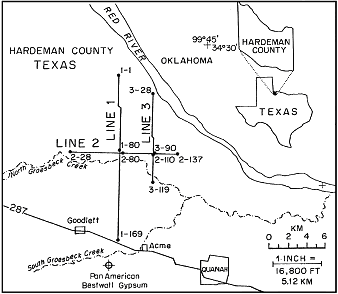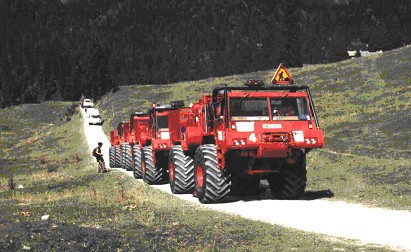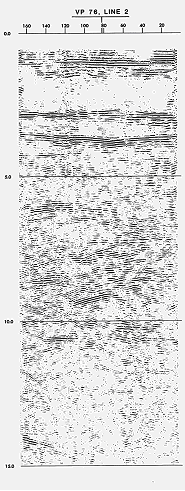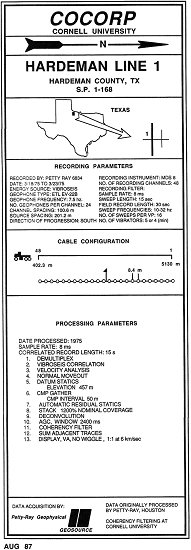
Fig. 1 – Location of the COCORP deep seismic profiling lines
in Hardeman County, Texas during 1975 (Lynn, 1979).
Updated: Dec 09, 2024
During the 1960's and 1970's the oil exploration industry was using seismic reflection profiling techniques extensively throughout the world in their quest to secure new oil and gas reserves. The reflection profiling technique for exploring sub-surface geological structures uses common-mid-point (CMP) seismic methods for data acquisition and image enhancement.
http://www.litho.ucalgary.ca/atlas/seismic.html
http://www.lithoprobe.ca/media/studies/seismicReflection.asp
http://www.lithoprobe.ca/media/studies/vibroseisTrucks.asp
Generally the exploration industry only acquired seismic profiling data sufficient for the purpose of identifying and evaluating oil and gas accumulations within sedimentary basin sequences and thus recording times were commonly only 6 seconds or less.
In the 1960's there had been reports from a number of countries (Germany, Canada, Australia, etc.) of seismic crews using extended recording times (up to 20 seconds) to record reflection data from within the basement rocks to the sedimentary basins. In some cases this produced images of geological features within basement rocks that were quite spectacular and geologically significant. This led eventually to the concept of using slightly modified oil industry seismic profiling techniques to systematically investigate the geological structure of basement rocks within the continental crust.
In USA, Dix (1965) summarised some work done in the Mojave Desert to develop seismic reflection profiling techniques to investigate the deep crust. He was optimistic that the reflection profiling technique would eventually provide detailed geology not evident from other wide-angle seismic profiling methods.
Most of the early deep seismic profiling in various countries used explosive seismic energy sources. The significant feature of program proposals in USA was to use VIBROSEIS seismic energy sources developed for the oil exploration industry. This method continues to be used with great success around the world for deep seismic profiling surveys.
Oliver et al (1976) summarised the history of early seismic reflection profiling as follows:
Junger (1951) presented perhaps the first well documented observations of near vertical reflections from deep intrabasernent horizons at a site in Montana, using prospecting instrumentation and techniques in vogue at that time. With the notable exception of work by Widess and Taylor (1959), Dix (1965), and a few isolated studies such as those by Narans and others (1961) and Perkins and Phinney (1971), the study of deep crustal reflections, particularly by the profiling technique, has received little attention in the United States, at least in the published literature. An unpublished Ph.D. thesis by Hasbrouck (1964) was ahead of its time in many ways, but it is little known and failed to stimulate further studies.
In certain foreign countries, seismic-reflection profiling of the basement has received considerable attention, particu!arly in recent years. In West Germany, where the application has been most thorough and advanced, Dohr, Fuchs, and Meissner have reported extensive studies over many years; this work is summarized in Dohr and Meissner (1975). Their approach and their results resemble in many ways those of the study presented here, which was designed partly on the basis of their experience. However. they used explosive, not vibratory, sources. Dohr and Meissner (1975) report that good or fair basement reflections were detected at about 85 percent of the sites sampled (about 50 in all) in West Germany. Such statistics are very promising. Liebscher (1964) also reported deep reflections at sites in West Germany. Robertson, Kanasewich, Clowes, Cumming, and others reported successful soundings of the basement in Alberta, Canada. Recent references are Robertson (1963) and Cumming and Chanura (1975). Detection of a major normal fault offsetting the Moho is an important geological result of the work of this group (Kanasewich and others, 1969). In Australia, Moss and Dooley (1973) report probable deep crustal and mantle reflectors at most of the 45 sites tested. Their early work was characterized by rather large explosions and was successful even though they used relatively simple detecting arrays and processing.
Most of the above foreign results were reviewed at a special symposium organized by COCORP at the annual meeting of the Society of Exploration Geophysicists in Mexico City in 1973. At that symposium, papers by Waters and Fowler (1973; see also Fowler and Waters, 1975), Meyer and Gettrust (1973), and Mateker and Ibrahim (1973) demonstrated feasibility of obtaining deep crustal information of certain types by the VIBROSEIS technique."
Jack Oliver was appointed to the Chairmanship of the Department of Geological Sciences, Cornell University, in 1971 and focussed his research on continental geology, in particular the deep geology. In 1973 he received a small grant from the National Science Foundation to look at the feasibility of deep seismic reflection profiling as a means of investigating deep geology. At the same time he recruited Sid Kaufman to the faculty at Cornell following his retirement from Shell as the Senior Research Physicist and assistant to the Vice-President for exploration research. Larry Brown was the third member of the Cornell team at the time as an Associate Professor. At the Society of Exploration Geophysicists Annual Meeting in Mexico City in 1973, there was a special session that reviewed deep seismic reflection experiments from around the world. Subsequently proposals were made for the establishment and funding of the Consortium for Continental Reflection Profiling (COCORP) to the US National Academy of Sciences as part of the US Program for the International Geodynamics Project (COCORP Newsletter No. 1, Oct. 1976). These proposals were accepted and funding was then forthcoming for the first three COCORP projects from the National Science Foundation (NSF). COCORP was in business (Society of Exploration Geophysicists: Virtual Geoscience Center, 2005; http://www.mssu.edu/seg-vm ).
The Executive Committee during these early days of COCORP was:
The Institute for the Study of the Continents (INSTOC), Cornell University, played a key role in initial planning and operations of COCORP and this has continued ever since these early days. The early COCORP organisation also had a Site Selection Advisory Committee, a Technical Advisory Committee and various sub-committees and correspondents. COCORP data are available to research groups via the COCORP web site:
http://www.geo.cornell.edu/geology/cocorp/COCORP.html
COCORP deep seismic profiling operations in the Hardeman Basin during 1975 recorded data along lines totalling 36.8 km in length (Fig. 1). The site was chosen because there had been some extended recording done during routine exploration for oil and gas that indicated reflections from within the basement rocks were likely to result in a good demonstration of the VIBROSEIS technique for deep seismic profiling (Oliver et al., 1976).
Petty Ray Geophysical, Inc., of Houston, Texas, was engaged for the data acquisition and computations. The field acquisition unit was a 48-channel MDS 8/Mandrel Data System; geophones were Electro Technical Laboratory EV22C with a natural frequency of 7.5Hertz; the VIBROSEIS technique was used, sources being five synchronized vibrators (three Y-1100, each of 13.5ton peak force, and two Y900, each of 10.5ton peak force).
Two days were spent prior to production work to establish the field parameters. Studies of source generated surface and near surface waves were made using single location sources and podded geophone spreads. Various arrays of vibrators and vibrator signal frequencies were studied. The parameters chosen for the production work were the following (Oliver et al. (1976):

Fig. 1 – Location of the COCORP deep seismic profiling lines
in Hardeman County, Texas during 1975 (Lynn, 1979).

Fig. 2 – A 1990's version of the Failing Y-1100 seismic vibrator
used in the 1975 COCORP work in the Hardeman County, Texas.


Fig. 3 - Seismic record sections to 15 seconds two-way time (TWT)
from Hardeman County Lines 1 and 2 (Nelson, 1988).


Fig. 4 - Seismic record sections to 15 seconds two-way time (TWT)
from Hardeman County Line 3 and the side label showing data acquisition
and processing parameters (Line 1) (Nelson, 1988).
Oliver et al (1976) summarised the initial results from this first COCORP deep seismic profiling survey.
Lynn (1979) interprets the COCORP Hardeman County data as follows:
(from http://sepwww.stanford.edu/theses/sep22/ )
"COCORP's Hardeman County. seismic experiment reveals what is interpreted as a silicic complex about 7.5 km thick, overlain by about 2.9 km of Palaeozoic sediments. The top 0.6 km of the complex approximately is porous tuff and flow generating layered reflections, grading downward into 3.5 km of seismically transparent rhyolite/granite. The lower 3.2 km of the complex between the two high amplitude reflectors. is interpreted as silicic to intermediate plutonic rocks. The reflectivity of the two high-amplitude seismic events suggests mafic sills about 800 m thick, and the more reflective (thicker?) lens is at the base of the pluton. This tabular silicic pluton is underplated by gabbroic rocks, rather than passing imperceptibly into migmatite. Our interpretation explains the sub-horizontal nature of the two high amplitude reflectors, the high reflection coefficient, and links the seismic data with the regional abundance of epizonal granite, rhyolite, and gabbro."
Brewer et al. (1981) interpret the Hardeman Basin results and adjacent COCORP data from south-western Oklahoma in the following terms:
"COCORP deep crustal seismic profiles in southwestern Oklahoma show strong, persistent, continuous, and undeformed layering in the basement over an area probably very much greater than 2,500km2. Such layering is very unusual, judging by COCORP experience with basement rocks elsewhere in the United States. The data can be interpreted as representing a Proterozoic basin filled with clastic sedimentary and felsic volcanic rocks 7 to 10km thick, whose base lies 10 to 13km deep. These rocks are believed, on the basis of sparse evidence from regional geology, to have been deposited or extruded about 1,200 to 1,400m.y. ago, and some of them may now be metamorphosed. This basin lies on the south side of the Wichita Mountains, under the Paleozoic Hardeman Basin, and is similar in depth to the Paleozoic Anadarko Basin north of the mountains."
However Miller et al (2001) suggest that alternative interpretations are possible.
"Seismic reflection data that image buried Precambrian rocks of the southern mid-continent commonly exhibit layering that recent work suggests has a variety of different origins. Layering beneath the Hardeman Basin of Oklahoma and Texas, first imaged in COCORP data in the 1970–s, is characterized by two or three very strong reflection packages against which lower amplitude reflections truncate in downlap or onlap geometries. While data from the Hardeman Basin might favor a sedimentary origin, data from the Palo Duro Basin are suggestive of an igneous origin.
Drill hole data, and recent geochemical and geochronologic data point to an episode of bimodal igneous activity at ~1.3Ga, that likely included intrusion of mafic sills and deposition of volcanoclastic strata, as the origin of the reflectivity. Seismic data from the central Permian Basin exhibits pervasive layering over a large area that is clearly correlated to a ~1.1 Ga massive layer intrusion, termed the Pecos Mafic Intrusive Complex (PMIC), on the basis of a synthetic seismogram from the North American Royalties #1 Nellie well which penetrated 4 km of the intrusion. Well data suggest that strong sub-horizontal reflectors in this package are due to mafic sills. New geochemical and geochronologic data from wells that penetrate basement in eastern New Mexico and the Texas Panhandle has been a major contributor to a more detailed understanding of the origin of reflectors in the southern mid-continent."
Brewer, J. A., Brown, L. D., Steiner, D., Oliver, J. E., Kaufman, S., and Denison, R. E., 1981. Proterozoic basin in the southern mid-continent of the United States revealed by COCORP deep seismic reflection profiling. Geology, 9, 569-575.
Clamming, G. L., and Chandra, N. N., 1975, Further studies of reflections front the deep crust in southern Alberta: Canadian jour. Earth Sci., v. 12. p. 539 557.
Dix, C. H., 1965, Reflection seismic crustal studies: Geophysics, v. 30, p. 1068 1084.
Dohr G., and Meissner, R., 1975, Deep crustal reflections in Europe: Geophysics, v. 40, p. 25-39.
Fowler, J. C., and Waters, K. H., 1975, Deep crustal reflection recordings using "VIBROSE!S" methods: A feasibility study: Geophysics, v. 40, p. 399 410.
Hasbrouck, W. R, 1964, A seismic reflection crustal study, in central eastern Colorado [PhD. thesis]: Golden, Colorado School Mines, 133 p.
Junger, A., 1951, Deep basement reflections in Big Horn County, Montana: Geophysics, v. 16, p. 499 505.
Kanasevvich, E. R., Clowes, R. M., and McCloughan, C. PL, 1969, A buried Precambrian rift in western Canada: Tectonophysics, v. 8, p. 513 527.
Liebscher, H. J., 1964, Deutungsverche fur die Struktur de tiefen Erdkrust nach reflexionsseismischen und gravimetrischen Messungen im deutschen Alpenvorland: Zeitschr. Geophysik, v. 30, parts 1 and 2, p. 51 125.
Lynn, H. B., 1979. Migration and interpretation of deep crustal seismic reflection data. Stanford University Thesis, 22 September, 1979.
Mateker, E. J., and Ibrahim, A. K., 1973, Deep crustal reflections from. a vibratory source (abs.): Joint 43rd Ann. Internat. Mtg. Soc. Exploration Geophysicists and the 5th Mtg. Assoc. Mexicana Geofis. Exploration, Mexico City, Oct. 21 25, 1973, Program, p. 31 32.
Meyer, R. P., and Gettrust, J. F., 1973, Feasibility studies for deep crustal reflection work [abs.]: joint 43rd Ann. Internat. Mtg. Soc. Expioration Geophysicists and S.th Mtg. Assoc. Mexicana Geofis. Exploration, Mexico City, Oct. 21 25, 1973, Program, p. 31.
Miller, K. C., Eshete, T., and Smith, D. 2001. An overview of the seismic characteristics of layered sequencies of the Precambrian basement of the southern mid-continent. Abstracts of the Geological Society of America Annual Meeting, November 5-8 2001, Boston.
Moss, F. J., and Dooley, J. C., 1973, Deep crustal and upper mantle reflection studies in Australia (abs.]: Soc. Exploration Geophysicists, Ann. Internat. Mtg., no. 43, p. 32 33.
Narans, H. D., Berg, J. W., and Cook, K. L., 1961, Sub basement seismic reflections in northern Utah: Jour. Geophys. Research, v. 66, p. 559 603.
Nelson, K. D., 1988. The COCORP Atlas. Institution for the Study of the Continents, Cornell University. Ithica, NY 14853, USA.
Oliver, J., Dobrin, M., Kaufman, S., Meyer, R. and Phinney, R., 1976. Continuous seismic reflection profiling of the deep basement, Hardeman County, Texas. Geol. Soc. Am. Bull., 87, 1537-1546.
Robertson, G., 1963, Intrabasement reflections in southwestern Alberta: Geophysics, v. 28, p. 910 915.
Waters, K. H., and Fowler, J. C., 1973, Deep crustal reflection recording using Vibroseis methods: A feasibility study [abs.l: Joint 43rd Ann. Internat. Mtg. Soc. Exploration Geophysicists and 5th Mtg. Assoc. Mexicana Geofis. Exploration, Mexico City. Oct. 21 25, 1973, Program, p. 30 31.
Widess, M. B., and Taylor, G. L., 1959, Seismic reflections from layering within the Precambrian basement complex, Oklahoma: Geophysics, v. 24, p. 417 425.
Perkins, W. E., and Phinney, R. A., 1971, A reflection study of the Wind River Uplift, Wyoming, in Heacock, G., ed., The structure and physical properties of the Earth's crust: Am. Geophys. Union Geophys. Mon. 14, p. 41 50.
[an error occurred while processing this directive]